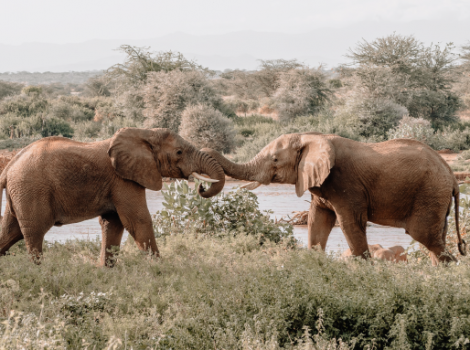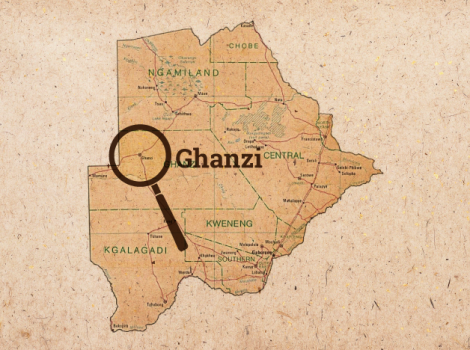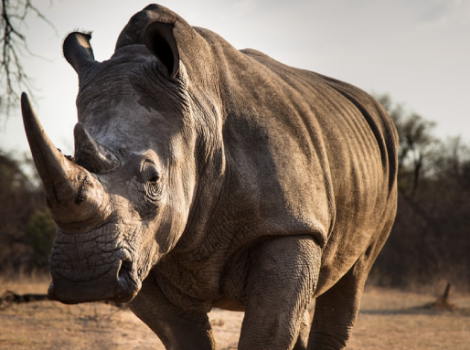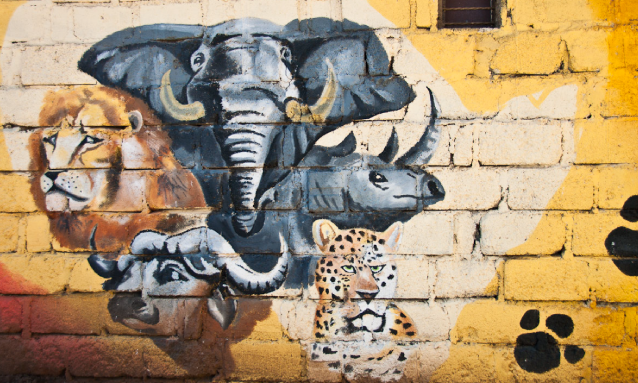
The infamous Big Five – the lion, the leopard, the elephant, the rhino and the buffalo – are all incredibly special creatures to see in their natural habitat and for that reason, are often sought after by tourists who spend huge amounts of money to go on African safari trips. Having spoken to and interacted with many friends of Botswana over the years, many visitors to Botswana would give their eyeteeth just to catch a glimpse of some if not all of the big 5.
The term “Big Five” originally referred to the difficulty that comes with trekking and hunting the lion, leopard, rhino, elephant and African buffalo. Additionally and on a sad note, because these five large African mammals are known for their ferocity when cornered, trophy hunters considered it a feat to bring them down.
Today, however, that’s changed to mean the ability to spot the Big Five while out on safari excursions as opposed to shooting them dead.
Where is the best place to spot the Big 5 in Botswana?
Botswana’s vast wilderness, which remains one of the most fertile, unspoilt and abundant destinations has on offer places such as the lush Chobe River and the Okavango Delta, which are ideal for spotting these incredible animals in their natural habitat.
To be in with a chance of seeing the Big Five in Botswana, you can visit some of the world-class national parks in the country. Here’s a little taster of what Botswana has in store for you:
Moremi Game Reserve / Okavango Delta
Moremi Game Reserve lies on the eastern side of the Okavango Delta in the north of Botswana. It is celebrated for both its abundant wildlife and stunning landscape. It covers 39,00 Square Kilometres in size, of which only 30% is mainland, while the rest makes up part of the Okavango Delta. Moremi Game Reserve is also regarded as one of the world’s best wildlife reserves.
Moremi is home to all the Big Five and in the dry winter months, elephant herds can be seen in their thousands, especially around the Mophane forests. Rhinos have been reintroduced to the area and the reserve is now one of the last sanctuaries for the vulnerable white and black rhinos.
Other animals you can expect to see at Moremi are giraffe, cheetah, impalas, jackal, Red lechwe and hippos. Moreover, keen birdwatchers can expect to be treated to well over 400 bird species, among them endangered species.
Chobe National Park
Chobe National Park is known for its high concentration of elephant and buffalo, making it one of the world’s most desirable safari destinations. With breath-taking scenery and the largest elephant population in Africa, Chobe is ideal for spotting the Big Five with relative ease. The 12,000 square kilometres expanse of the National Park is home to a number of wildlife species and the diverse ecosystem. From dry plains, luscious grasslands to swamps and even densely wooded areas, the Chobe area is certainly a safari enthusiast’s dream.
Because the Savuti marsh in the area is home to an array of wildlife including the Big Five that can be seen all year round, a trip to Chobe never disappoints. YourBotswana would like to point out, however, that although there’s every chance you will see them, rhinos are rare to spot. Visitors to the Chobe area are able to enjoy an array of game viewing excursions on a boat cruise along the Chobe River, a guided safari trip through the diverse shrubbery to Chobe National Park.
Fascinating facts about the Big 5
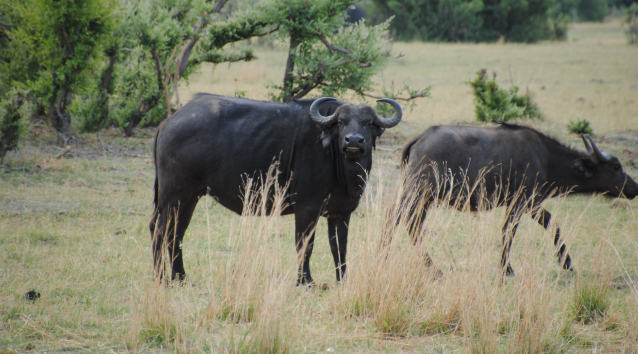
African/Cape Buffalo
Weighing in at a whopping 700kg (1,500lb), the African or Cape buffalo is unpredictable and dangerous if cornered. They have been known to ambush men and are often accused of being scheming and very sneaky, but are placid if left alone.
The predator that remains the buffalo’s primary predator is the lion. Buffalo will try to rescue a member of their herd if caught by a predator and have in fact been seen killing a lion to avenge the death of a buffalo at the hands of lions!
Although the African and water buffalos look almost identical, the two are not believed to be closely related! Also, unlike the water buffalo, the African buffalo has never been domesticated.
The African buffalo is one of the most abundant of Africa’s large herbivores. It will also not live in an area with less than 10 inches of rainwater.

Rhino
These large, primitive-looking mammals have been hunted to near extinction; since 1970 the rhino population has declined by 90%. The white or square-lipped rhino is one of two species. The black or hook-lipped rhino is an odd-toed ungulate (three toes on each foot). Both the black and white rhino have two horns.
The closest living rhino “relatives” are tapirs, horses and zebras. They are part of a group of mammals called odd-toed ungulates.
Rhinos have poor vision and will sometimes attack trees and rocks by accident. However, to compensate for their poor sight, their hearing and sense of smell are excellent.
The rhino is the most endangered species of the Big Five. In 2009 worldwide Rhino poaching hit a 15-year high. The illegal trade is being driven by a huge demand for horns in Asia, made worse by increasingly sophisticated poachers who are now using veterinary drugs, poison, cross bows and high calibre weapons to kill rhinos. Very few rhinos now survive outside national parks and reserves.
White rhinos aren’t actually white, but slate grey to yellowish brown in colour. The species’ name actually takes its root from the Dutch word, “weit” (wide), in reference to the animal’s sheer width in size.
Rhinos are very inventive and make their own sunblock! They will soak in mud for up to three hours at a time, this to protect their skin from pesky creatures and the scorching hot sun.

Lion
African lions are the most social of all the big cats and live together in prides. A pride consists of up to 15 lions. The lion stands out from the other big cats not just in its distinctive appearance but also in being the only member of the cat family that lives in organised social groups. Adult males typically weigh up to 225kg and grow up to 3m in body length.
Prey consists of medium to large herd animals. When there’s been a kill it is common for the males to eat first, even though they take no part in the hunting process. Male lions defend the pride’s territory while females do most of the hunting.
Typically; the darker a lion’s mane, the older he is. Lions are found only in Africa.
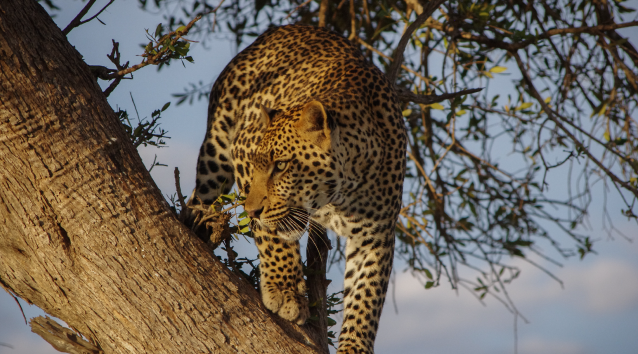
Leopard
The leopard’s powerful limbs and neck muscles enable it to carry a fully – grown male antelope or even young giraffe, often weighing up to three times its own body weight, high into the tree tops.
Leopards are great tree climbers and can often be spotted lounging leisurely on trees. They’ll often drag their kill up a tree to ensure lions and hyenas don’t get their greedy hands on it. They are the strongest climbers of the large cats.
It can be extremely hard to spot leopards, no wonder they are the least seen of the Big Five. The fact that leopards are nocturnal, solitary, and tend to stay hidden during the day combine to make them very difficult to spot.
Leopard cubs are born blind and completely rely on their mothers. Their eyes begin to open after about ten or more days and for the first few months, their eyes are bright blue!
Unbeknownst to many, leopards are also fantastic swimmers and occasionally snack on fish. A bit strange for a member of the cat family!

The African Elephant
The African elephant is the largest living land mammal. The biggest can be up to 7.5m long, 3.3m high at the shoulder, and 6 tonnes in weight.
The muscular trunk serves as a nose, hand, an extra foot, signalling device and a tool for gathering food. With 40,000 muscles, the trunk performs movements as delicate as picking berries.
African elephants communicate across large distances of up to 5 miles at a frequency so low frequency it cannot be heard by humans.
Many plant species have evolved seeds that are dependent on passing through an elephant’s digestive tract before they can germinate. At least one third of tree species in West African forests rely on elephants in this way for dissemination.
Sadly, over the years all of the Big 5 animals numbers have dwindled to an all – time low as a result of environmental issues, poaching and trophy killing. It is heartbreaking to imagine that within a decade, these majestic animals could be wiped off the face of the earth but that is the reality we have to face.
Did you enjoy this article? Please share it and spread awareness and/or share your views on YourBotswana.
Image credits: Wall art – Vasylysk / Lioness – Bram Vranckx / Leopard – Hidde Rensink / Elephants – Larry Li / Rhino – Joel Herzog / Buffalo – Diego Cue

